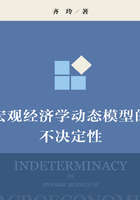
Preface
Indeterminacy in macroeconomic dynamic models is a notable problem in recent two decades.
In mathematics, on the one hand, it is a problem of the stability of the dynamic systems, on the other hand, in economic growth models, it becomes the problem that there exist multiple paths with different transitions to convergent to the same steady state. In economy, it can be explained as follows:two countries with the same geographical and the same nature environment, but they may have different develop paths. Thus, with what conditions, indeterminacy can generate is an important research in literature of macroeconomics.
At the beginning of the research on this problem, it focus on two-sector models, because the different distribution pattern of the factors between the two sectors will cause indeterminacy. Since it was found in one-sector models that indeterminacy can happen in the model with increasing returns of scale technologies, the research on how to generate the indeterminacy has continued. However, it is more difficult to generate indeterminacy in the one-sector case than that have be done in the two-sector case.
The concavity of the utility function and the un-uniqueness of the solution to dynamic system in Jaimovich and Rebelo model. Jaimovich and Rebelo studied the effects of the income on leisure demand, and then the effects on labor supply with a special utility function. Recently, there are some papers using this utility function to analyze the indeterminacy in the one-sector model. I found that this utility is not concave, then the optimal solutions to the dynamic system are not unique. The proofs in the three chapters all proved by myself. This is very new in the study on the problem in the economic growth field.
This book includes five chapters. Chapter 1 is an overview on literature of indeterminacy, Chapter 2 is an overview on indeterminacy in one-sector models. Chapter 3 studies the concavity of instantaneous utility function in Jaimovich and Rebelo(2009). Chapter 4 studies the concavity of the utility function in multiple periods, Chapter 5 proves there exists no unique optimal solution to the dynamic system in Jaimovich and Rebelo.
This book was supported by the MOE Project of Key Research Institute of Humanities and Social Science in Universities 15JJD790037 of the Ministry of Education of the Peoples'Republic of China. I also appreciate the leadership of our institute for their support on writing of this book.
Ling Qi
China Institute for Actuarial Science
Central University of Finance and Economics
April 4,2017